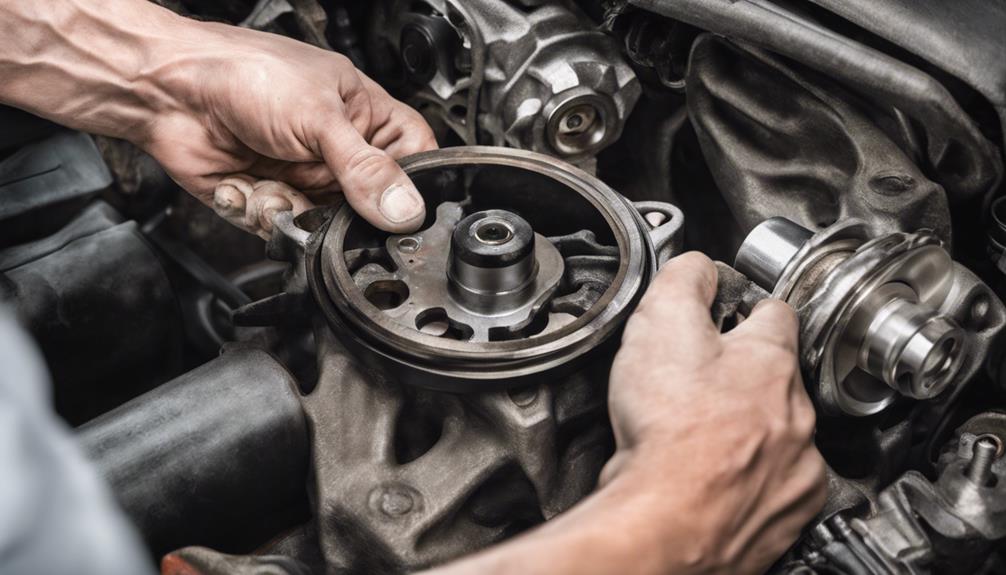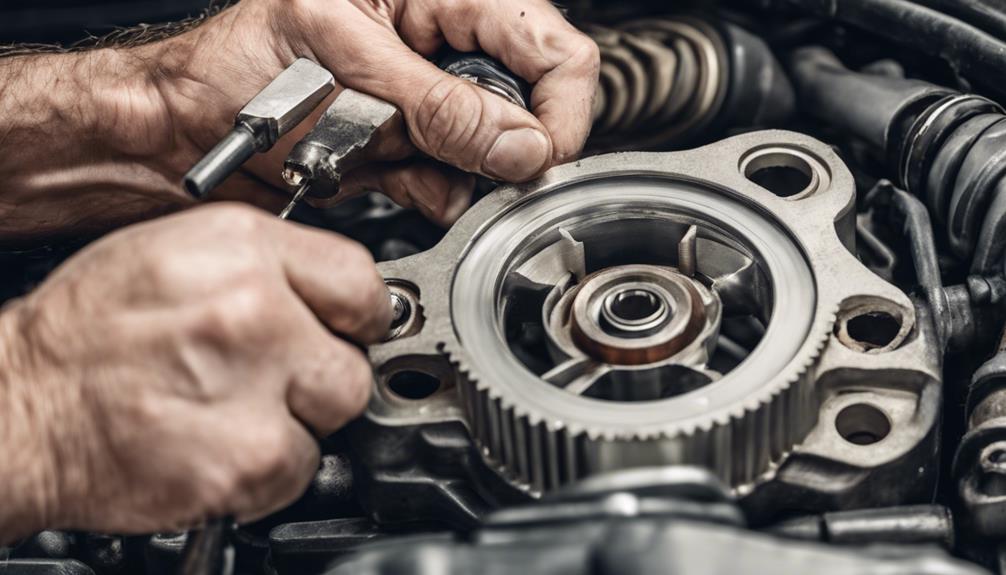Beginner's Guide to DIY Timing Belt Replacement
Are you ready to tackle the challenge of replacing your timing belt on your own? The process may seem daunting, but with the right guidance and preparation, you can successfully complete this critical maintenance task.
Understanding the intricacies of your vehicle's engine components is crucial, but what about the tools you'll need and the steps involved in the replacement?
Stay tuned to discover essential tips and insights that will help you navigate through this DIY project with confidence.
Key Takeaways
- Replacing timing belt prevents engine damage and boosts performance
- Proper tools and safety gear are vital for successful replacement
- Careful handling and alignment ensure correct installation
- Testing and tuning post-replacement ensures optimal engine function
Importance of Timing Belt Replacement
Why is timing belt replacement crucial for the longevity and performance of your vehicle's engine?
Timing belt replacement plays a vital role in ensuring engine longevity and optimal performance. By synchronizing the camshaft and crankshaft rotation, the timing belt facilitates the precise timing of the engine's valves, allowing for efficient combustion and power generation. Neglecting timely replacement can lead to belt failure, resulting in severe engine damage that could incur significant repair costs.
Moreover, a well-maintained timing belt contributes to smoother engine operation, enhancing overall performance and fuel efficiency. By adhering to the recommended replacement intervals, typically between 60,000 to 100,000 miles, you not only safeguard your engine from potential harm but also potentially save on costly repairs in the long run. Consult your vehicle manual for specific guidelines tailored to your car's make and model to ensure optimal engine health and cost savings.
Tools Needed for Timing Belt Replacement
For a successful timing belt replacement, gather essential tools such as a 10mm socket wrench, a breaker bar, and a chain wrench. These tools are crucial for efficient removal and installation of the timing belt, tensioner, and idler. To ensure smooth operation, it's essential to maintain your tools regularly. Keep them clean, lubricated, and stored in a dry place to prevent rust and damage. Additionally, prioritize tool safety during the replacement process. Always wear appropriate safety gear like gloves and safety glasses to protect yourself from potential injuries.
In addition to the basic tools, you'll also need a 22mm deep socket and a large cheater bar for removing the crank bolt. When compressing the timing belt tensioner, use a bench vise to facilitate alignment and installation. Proper tool maintenance and safety practices not only make the replacement process easier but also ensure the longevity of your tools for future projects.
Steps to Remove Old Timing Belt

To initiate the process of removing the old timing belt, begin by loosening the tensioner pulley carefully to facilitate belt removal without causing damage to surrounding components. Before proceeding, ensure that the timing marks are correctly aligned to maintain the engine's timing integrity. Using a breaker bar can provide the necessary leverage to release tension on the belt effectively.
As you loosen the tensioner and remove the old timing belt, inspect it thoroughly for signs of wear, such as cracks, fraying, or missing teeth. Keeping track of the belt's positioning and teeth count is crucial for the reinstallation process to ensure proper engine function. Be attentive to the belt's condition and any wear patterns that may indicate underlying issues with the engine or pulley system.
Remember to handle the old timing belt with care and avoid any sudden movements that could harm other engine components. By following these steps diligently, you're one step closer to successfully replacing your timing belt and maintaining your engine's optimal performance.
Installing the New Timing Belt
When installing the new timing belt, ensure precise alignment with the timing marks on both the camshaft and crankshaft sprockets. To successfully complete this task, follow these steps:
- Align Timing Marks: Before placing the new belt, make sure the timing marks on the camshaft and crankshaft sprockets are perfectly aligned. This is crucial to prevent any timing issues later on.
- Carefully Route the Belt: Take extra care when routing the new belt around the sprockets. Any misalignment or skipping of teeth can cause serious engine damage, so ensure the belt sits correctly in place.
- Avoid Independent Rotation: Don't rotate the camshaft or crankshaft independently, especially on interference engines. Doing so could lead to valve-piston interference, resulting in catastrophic engine failure.
- Follow Tightening Procedure: Once the belt is in place, follow the manufacturer's recommended procedure to properly tighten it. Pay special attention if hydraulic tensioners are involved to ensure the correct tension is applied for optimal performance.
Testing and Fine-Tuning the Timing Belt

After ensuring precise alignment and installation of the new timing belt, the next step involves testing and fine-tuning to guarantee optimal performance and longevity. Begin by using a timing light to verify that the timing marks are correctly aligned after replacing the belt.
Fine-tune the belt tension according to the manufacturer's specifications or guidelines to ensure proper functioning. Check for smooth engine operation and correct timing post-replacement.
Start the engine and listen for any unusual noises or vibrations, which could indicate issues with the timing belt installation. If needed, adjust the tensioner to achieve the desired tension for ideal performance and longevity.
Frequently Asked Questions
Is It Easy to Replace a Timing Belt Yourself?
Replacing a timing belt yourself involves precision and attention to detail. It may vary in difficulty based on experience and tools available. Ensuring proper timing belt tension is crucial for engine performance. Access to timing belt area and following a detailed guide are essential.
What Are the Steps to Replacing a Timing Belt?
Replacing a timing belt involves meticulous steps like adjusting the timing belt tensioner and replacing the water pump. It's like performing surgery on your car's heart. Follow precise procedures to ensure proper alignment and functionality.
Is It Hard to Put a Timing Belt On?
Installing a timing belt can be challenging. Achieving correct timing belt tension and precise belt alignment are critical. To avoid engine damage, pay close attention to these factors. Take your time and follow manufacturer guidelines for optimal performance.
How Many Hours Does It Take to Replace a Timing Belt?
Replacing a timing belt usually takes around an hour, depending on the vehicle's complexity. Common tools required include ratchet wrenches and sockets. Avoid rushing to prevent mistakes. Compared to a professional service, DIY can save significant costs.
Conclusion
In conclusion, replacing your timing belt is a crucial maintenance task that can prevent costly engine damage. By following the steps outlined in this guide and using the right tools, you can successfully complete the replacement process.
For example, John, a beginner DIY enthusiast, saved over $500 by replacing his timing belt himself and gained valuable knowledge about his vehicle in the process. Remember, proper timing belt maintenance is key to keeping your engine running smoothly.







